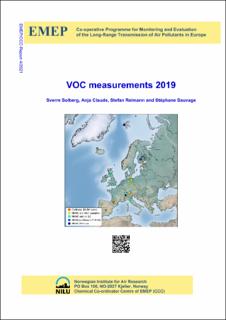| dc.description.abstract | This report presents VOC (volatile organic compound) measurements carried out during 2019 at EMEP monitoring sites. In total, 19 sites reported VOC-data from EMEP VOC sites this year. Some of the data-sets are considered preliminary and are not included in the report.
The monitoring of VOC has become more diverse with time in terms of instrumentation. Starting in the early 1990s with standardized methods based on manual sampling in steel canisters and adsorption tubes with subsequent analyses at the lab, the methods now consist of a variety of instruments and measurement principles, including automated continuous monitors and manual flask samples.
Within the EU infrastructure project ACTRIS, data quality issues related to measurements of VOC are an important topic. Many of the institutions providing VOC-data to EMEP are participating in the ACTRIS infrastructure project, either as formal partners or on a voluntary basis. Participation in ACTRIS means an extensive effort with data-checking including detailed discussions between the ACTRIS community and individual participants. There is no doubt that this extensive effort has benefited the EMEP-program substantially and has led to improved data quality in general.
Comparison between median levels in 2019 and the medians of the previous 10-years period, revealed similar geographical patterns as in the previous years. Changes in instrumentation, procedures and station network with time make it difficult though to provide a rigorous and pan-European assessment of long-term trends of the observed VOCs. In this report, we have estimated the trends in NMHC over the 2000-2019 period at five sites by three independent statistical methods. All three methods gave comparable estimates of the trends, although the Mann-Kendall method based on annual data (compared to daily data for the other two methods) found fewer significant trends.
These estimates indicate marked differences in the long-term trends for the individual species. Small or non-significant trends were found for ethane during 2000-2019. Propane also showed fairly small reductions. On the other hand, components linked to road traffic (ethene, ethyne and benzene) showed the strongest drop in mean concentrations, up to 60-80% at some stations. | en_US |
